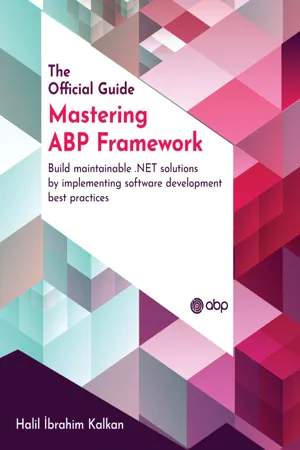
- 526 pages
- English
- ePUB (mobile friendly)
- Available on iOS & Android
Mastering ABP Framework
About this book
Learn how to build modern web applications from the creator of ABP Framework
Key Features
- Build robust, maintainable, modular, and scalable software solutions using ABP Framework
- Learn how to implement SOLID principles and domain-driven design in your web applications
- Discover how ABP Framework speeds up your development cycle by automating repetitive tasks
Book Description
ABP Framework is a complete infrastructure for creating modern web applications by following software development best practices and conventions. With ABP's high-level framework and ecosystem, you can implement the Don't Repeat Yourself (DRY) principle and focus on your business code.Written by the creator of ABP Framework, this book will help you to gain a complete understanding of the framework and modern web application development techniques. With step-by-step explanations of essential concepts and practical examples, you'll understand the requirements of a modern web solution and how ABP Framework makes it enjoyable to develop your own solutions. You'll discover the common requirements of enterprise web application development and explore the infrastructure provided by ABP. Throughout the book, you'll get to grips with software development best practices for building maintainable and modular web solutions.By the end of this book, you'll be able to create a complete web solution that is easy to develop, maintain, and test.
What you will learn
- Set up the development environment and get started with ABP Framework
- Work with Entity Framework Core and MongoDB to develop your data access layer
- Understand cross-cutting concerns and how ABP automates repetitive tasks
- Get to grips with implementing domain-driven design with ABP Framework
- Build UI pages and components with ASP.NET Core MVC (Razor Pages) and Blazor
- Work with multi-tenancy to create modular web applications
- Understand modularity and create reusable application modules
- Write unit, integration, and UI tests using ABP Framework
Who this book is for
This book is for web developers who want to learn software architectures and best practices for building maintainable web-based solutions using Microsoft technologies and ABP Framework. Basic knowledge of C# and ASP.NET Core is necessary to get started with this book.
]]>
Frequently asked questions
- Essential is ideal for learners and professionals who enjoy exploring a wide range of subjects. Access the Essential Library with 800,000+ trusted titles and best-sellers across business, personal growth, and the humanities. Includes unlimited reading time and Standard Read Aloud voice.
- Complete: Perfect for advanced learners and researchers needing full, unrestricted access. Unlock 1.4M+ books across hundreds of subjects, including academic and specialized titles. The Complete Plan also includes advanced features like Premium Read Aloud and Research Assistant.
Please note we cannot support devices running on iOS 13 and Android 7 or earlier. Learn more about using the app.
Information
Part 1: Introduction
- Chapter 1, Modern Software Development and ABP Framework
- Chapter 2, Getting Started with ABP Framework
- Chapter 3, Step-by-Step Application Development
- Chapter 4, Understanding the Reference Solution
Chapter 1: Modern Software Development and ABP Framework
- Challenges of developing an enterprise web solution
- Understanding what ABP Framework offers
Challenges of developing an enterprise web solution
Setting up the architecture
Don't repeat yourself!
Building a UI base
Implementing common business requirements
Table of contents
- Mastering ABP Framework
- Foreword
- Preface
- Part 1: Introduction
- Chapter 1: Modern Software Development and ABP Framework
- Chapter 2: Getting Started with ABP Framework
- Chapter 3: Step-By-Step Application Development
- Chapter 4: Understanding the Reference Solution
- Part 2: Fundamentals of ABP Framework
- Chapter 5: Exploring the ASP.NET Core and ABP Infrastructure
- Chapter 6: Working with the Data Access Infrastructure
- Chapter 7: Exploring Cross-Cutting Concerns
- Chapter 8: Using the Features and Services of ABP
- Part 3: Implementing Domain–Driven Design
- Chapter 9: Understanding Domain-Driven Design
- Chapter 10: DDD – The Domain Layer
- Chapter 11: DDD – The Application Layer
- Part 4: User Interface and API Development
- Chapter 12: Working with MVC/Razor Pages
- Chapter 13: Working with the Blazor WebAssembly UI
- Chapter 14: Building HTTP APIs and Real-Time Services
- Part 5: Miscellaneous
- Chapter 15: Working with Modularity
- Chapter 16: Implementing Multi-Tenancy
- Chapter 17: Building Automated Tests
- Other Books You May Enjoy